Bottomland Hardwoods Natural Regeneration Using the Shelterwood System

Regenerating bottomland oaks can be difficult and carries a set of problems unique to bottomland sites. The high costs of artificial regeneration deter most landowners, yet they rarely make provisions for natural regeneration before harvesting these stands. An oak shelterwood system can effectively establish vigorous oak advanced regeneration in bottomland hardwood stands. It provides an affordable means of reestablishing a stand using existing trees as a seed source.
Why Focus on Oaks?
In hardwood stands, woody, non-oak species may have commercial, aesthetic, wildlife, and other values. However, coupled with the intensified herbaceous competition inherent to many bottomland sites, these species often have serious negative competitive effects on developing oak seedlings. Oaks are very important for wood production, they provide wildlife habitat, and they have aesthetic and environmental benefits. Oak species are often viewed as the most valuable species group for many management objectives. Consequently, oak species are usually favored in bottomland hardwood management practices and will be the focus of this publication.
Natural Regeneration
Natural regeneration is the process of regenerating a forest from trees already present in the stand. The shelterwood system is designed to establish oak advanced regeneration to ensure an oak-dominant forest after harvest. Three types of regeneration are produced: 1) freshly germinated seedlings, 2) advanced regeneration, and 3) stump sprouts. Stump sprouting is rarely the focus in bottomland shelterwood efforts, and sprouts do not contribute greatly to overall regeneration success in these stands. For these reasons, they will not be discussed in this publication.
Freshly Germinated Seedlings
Freshly germinated seedlings are very young, and large numbers of these seedlings often exist in bottomland stands the year after heavy mast crops. They are usually only a few inches tall, with root collar diameters of less than 0.2 inch and small root systems lacking enough energy reserves for successful competition with on-site herbaceous vegetation. In addition, they are too small to compete successfully for light when overtopped by vigorous herbaceous weed complexes that are often present on bottomland sites. Very few of these seedlings become established after harvest, and most die during the first growing season after germination. Accordingly, managers cannot rely on freshly germinated oak seedlings to regenerate a bottomland hardwood stand.
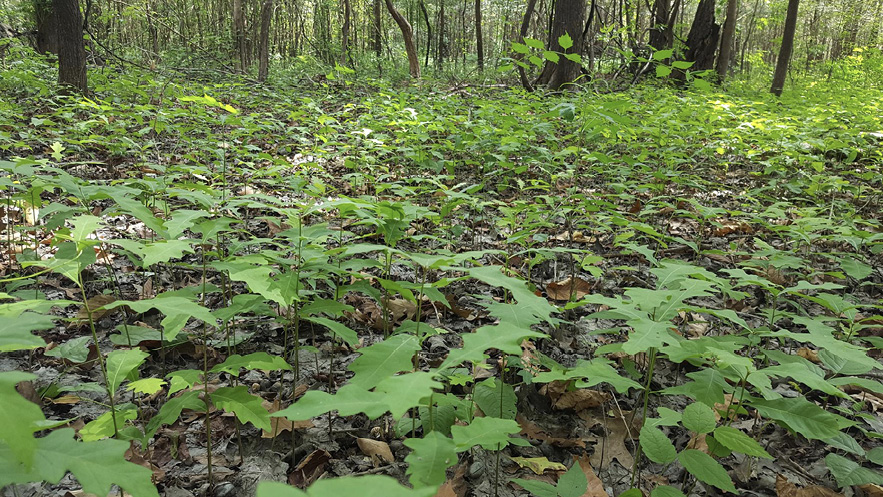
Advanced Regeneration
Advanced regeneration refers to well-established seedlings with good root systems existing before harvest. These seedlings should be between 1 and 4 feet tall and have root collar diameters of at least one-fourth of an inch.
Because of their established root systems, these seedlings are much better positioned to compete for growing space in newly regenerated stands. Advanced regeneration is the most important element of successful bottomland shelterwood efforts.
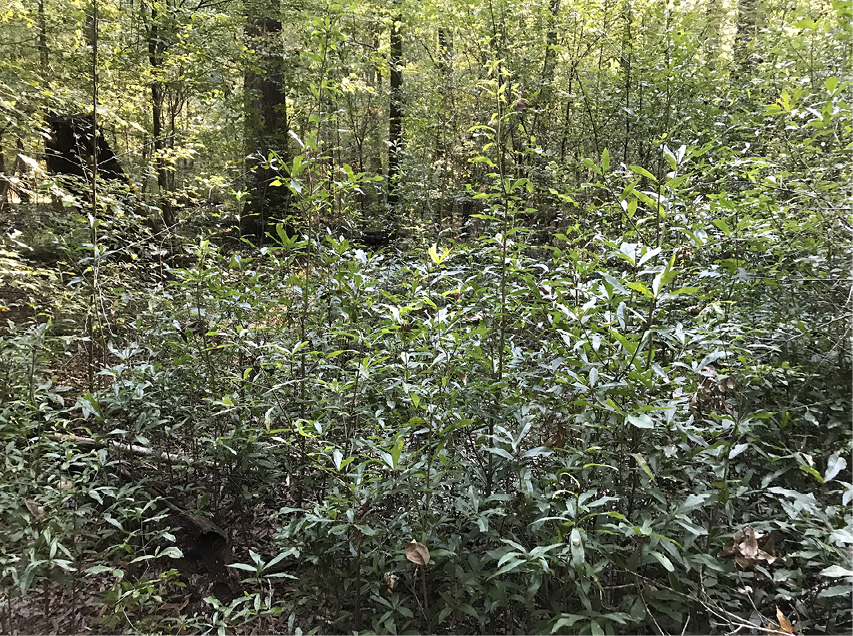
Challenges of the Shelterwood System in Bottomland Forests
If oaks are to be a significant component of the next stand, obtaining oak advanced regeneration is a necessity. Several factors determine the difficulty and likelihood of establishing sufficient quantities of regeneration in bottomland stands. These include species/site relationships, species composition, seedling size, and herbaceous competition.
Species/Site Relationships
Bottomland hardwood sites have highly variable soils with a wide range of productivity and species suitability across a given area. Site differences are driven by topographical changes resulting from flooding events over time. Elevational changes of as little as 6 inches may completely change site suitability for a given species due to
variations in drainage class, onsite vegetation, soil texture, soil structure, or pH. Various species have adapted to survive and grow best only under certain site conditions, and many hardwood species do not have a wide range of site suitability. Even within the same species group, different species may have vastly different soil, moisture, and nutritional tolerances.
Typically, seedlings established from seed of onsite trees will be adapted to the site; however, site conditions sometimes change, resulting in a situation where overstory trees are no longer appropriate for the conditions. It is important to ensure proper species/site matches for the species being regenerated; otherwise, regeneration efforts can fail. For a more thorough explanation of bottomland hardwood species/site relationships, please read Mississippi State University Extension Publication 2004 Bottomland Hardwood Management: Species/Site Relationships.

Species Composition
Species composition is extremely important in determining the feasibility of shelterwood establishment and estimating the amount of advanced regeneration needed. First, an adequate number of somewhat evenly distributed oak trees must exist in the current stand for the shelterwood system to work. In addition, if a stand has substantial numbers of fast-growing, shade-intolerant species like sweetgum, more oak advanced regeneration will likely be required to ensure survival of adequate numbers of oak seedlings in the newly regenerated stand. Many bottomland hardwood stands have a substantial component of shade-tolerant species like elms, maples, and American hornbeam. These species can create significant competition problems for oak regeneration. If this competition becomes problematic, some form of chemical control (i.e., injection or directed spray applications of herbicides) is typically necessary to reduce the undesirable trees within a stand.
Seedling Size
The size of seedlings is extremely important in determining adequacy of advanced regeneration. Advance regeneration should be between 1 and 4 feet tall compared to the 2 to 6 inches of freshly germinated seedlings. If the majority of regeneration is less than 1 foot in height, the likelihood of success is much lower, and many more seedlings will be needed.
Herbaceous Competition
Overall, highly fertile, moisture-rich soils typical of bottomland sites promote herbaceous competition. Herbaceous competition in bottomlands is often much more intense than in upland hardwood systems. Freshly germinated seedlings, and even smaller advanced regeneration, often cannot survive the competition resulting from exposure to full sunlight after clearcutting operations. In these scenarios, some form of herbaceous weed control is often necessary (see MSU Extension
Publication 2873 Herbicide Options for Hardwood Management for detailed herbicide application instructions). However, the shelterwood approach is designed to provide enough shade to limit growth of herbaceous species while maintaining adequate light for the development of oak advanced regeneration.
What Is a Shelterwood?
Silvicultural management of forests is classified by regeneration systems. These systems are designed as sets of procedures that lead the practitioner through a stand’s rotation with an end goal of an adequately regenerated stand. The shelterwood regeneration system has proven to be the most successful system available for natural regeneration of bottomland oak species in the South. Clearcutting (removing all trees at once) is another common regeneration system and, if applied properly, it can be an excellent method for regenerating desirable hardwoods. However, if an adequate number of oak advance regeneration is not present at the time of harvesting and all overstory canopy trees are not removed, oak reestablishment is unlikely. Clearcutting operations often focus only on maximizing profit and leave substantial numbers of small-diameter trees of undesirable species that make development of desirable species like oaks difficult.
The shelterwood system is designed to promote the establishment of an adequate quantity of high-vigor oak advanced regeneration for the next stand before final harvesting. Evaluate overstory stems to assess the overall health and quantity of appropriate seed-source trees. Candidate shelterwood stands should have at least 50 healthy codominant/dominant stems of a desirable oak species per acre. If stands are deemed suitable for shelterwood establishment, the process may begin.
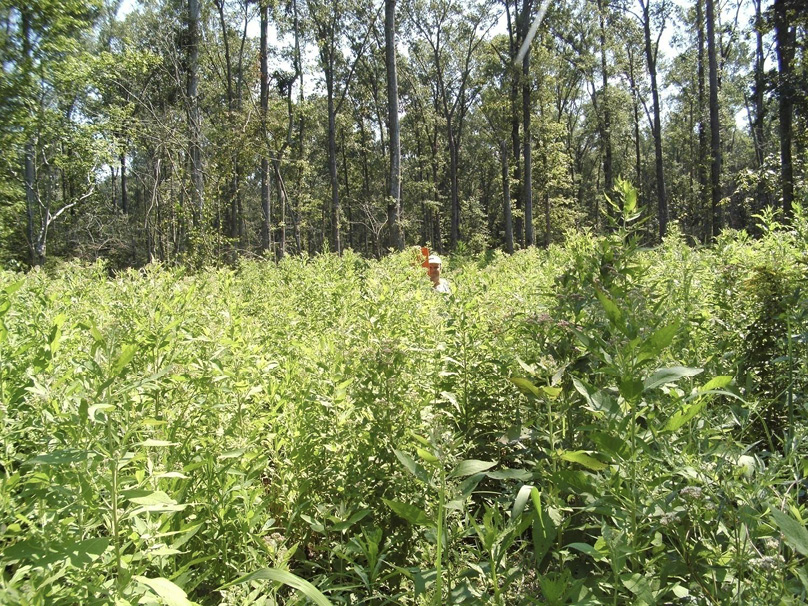
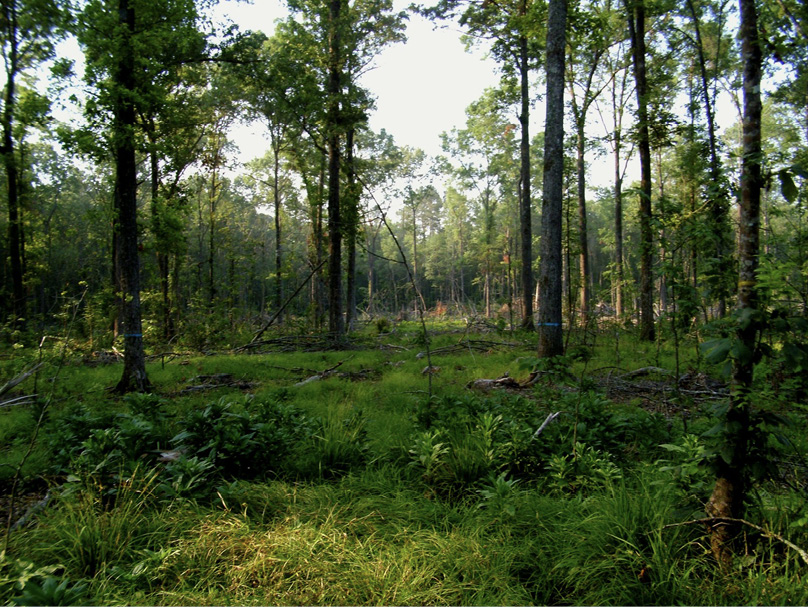
Shelterwood operations use midstory control along with a series of cuts designed to leave mature trees of desirable species that produce and protect regeneration. By definition, shelterwood systems use at least three different overstory removal cuts. The first, a preparatory cut, involves removing low-quality, low-vigor stems and is intended to increase overall vigor of the stand. The second, a seed cut, is designed to open the overstory canopy and encourage establishment of desirable regeneration. The third and final cut, called a removal cut, removes residual overstory stems overshadowing the newly established stand of oak advanced regeneration. However, in practice, the shelterwood system is commonly modified to involve only two cuts, combining preparatory and seed cuts into one operation.
When overstory removal increases light availability to the midstory and understory, competing vegetation responds by either germinating or increasing leaf production. These species are often able to outcompete freshly germinated seedlings and small advanced regeneration. Thus, the first step in a shelterwood operation is removing small-diameter stems of undesirable species in order to reduce competition and promote desirable regeneration by increasing light availability. In stands with large numbers of these non-merchantable trees, the process is usually accomplished using stem injection, hack-n-squirt, or basal bark herbicide applications. Herbicides used in these treatments are typically soil-active; be very careful not to allow the herbicide to spill, drip, or run out/off of treatment surfaces. For more specific information on these applications, please read MSU Extension Publication 2942 Tree Injection for Timber Stand Improvement. For best results, injection should take place during the year preceding the first overstory removal step in the shelterwood.

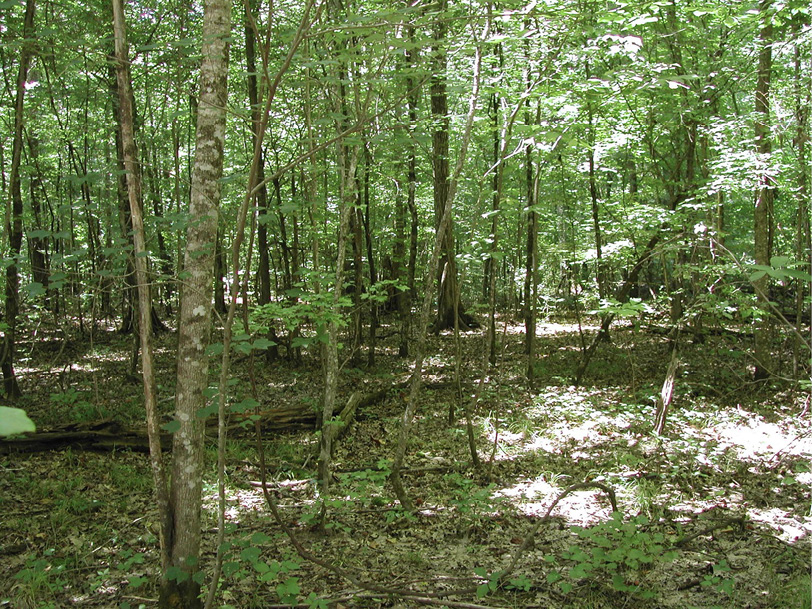
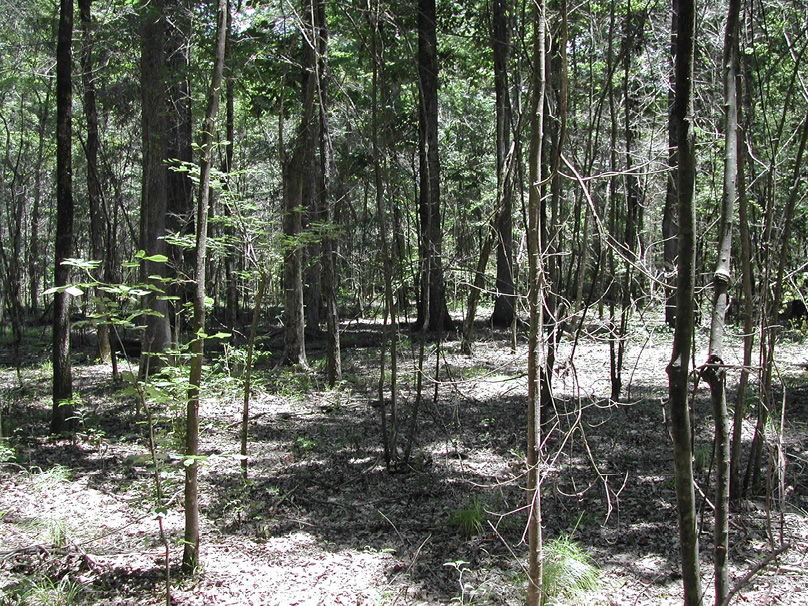
The next step in the process is removing a portion of the overstory trees. This can be through a preparatory cut or as a combination of preparatory and seed cuts. The purpose of this cut is to open the overstory enough to allow sufficient sunlight through to establish regeneration. This cutting should take place immediately before a good mast crop. For detailed information on evaluating acorn production, please see MSU Extension Publication 2904 Managing Hardwood Stands for Acorn Production.
Typically, 50 to 60 percent of canopy trees should be removed. This will produce optimal light conditions for oak regeneration while leaving enough trees to provide shade to reduce herbaceous competition. Research over the last half-century has proven that the optimal level of light for regenerating bottomland oak species is approximately 50 percent available light. In this context, “available light” refers to photosynthetically active radiation (PAR), or light that plants can use for photosynthesis. However, meeting the 50 percent PAR target exactly is difficult, and an acceptable range is 40 to 60 percent available light. Fifty percent available light typically occurs with overstory stem densities of approximately 50 square feet of basal area. Basal area is a measure of a cross-sectional area of trees in
a stand at 4.5 feet aboveground. For detailed information on basal area, see MSU Extension Publication 3590 Using the MSU Basal Area Angle Gauge.
The goal of regeneration is not to establish a pure oak stand, but one with a significant oak component (at least 40 percent). Assess the amount of oak advanced regeneration using 100th-acre (11.8-foot radius) circular plots. Tally seedlings in the sample area by size class (less than 1 foot, 1 to 3 feet, and greater than 3 feet), and convert to per-acre values after collecting data from several plots. Take one regeneration plot for every 2 acres in smaller stands (up to 40 or 50 acres). The ratio of plots per acre can increase in larger stands, but be sure to record regeneration data on at least 25 to 30 plots spread across the stand. Use this data to determine if a stand is sufficiently stocked to a level that oak can be expected in the newly established stand.
The shelterwood system consistently provides the best results for establishing natural regeneration in bottomland oaks. The time from start to finish varies, ranging from 2 to 5 years and, in some cases, 10 years or longer to establish oak advanced regeneration large enough to compete when the residual overstory is removed. Multiple MSU research projects have found that the shelterwood process yields excellent results in establishing advanced regeneration in bottomland oak stands. When implemented correctly, it is not unusual to achieve oak advanced regeneration densities exceeding 1,000 seedlings per acre. These high seedling densities allow for seedlings lost to natural mortality while leaving quality stems for the future stand.

After adequate regeneration is established, harvest the remaining overstory trees in one final removal cut. It is not operationally feasible in the South to use multiple cuts. Final removal should take place once oak advanced regeneration reaches an average height of 3 to 4 feet and before it reaches a size where substantial mechanical damage from logging may occur (more than 6 or 7 feet in height). Some owners may want to maintain these trees for aesthetic purposes, but residual trees will impede oak regeneration.
Conclusion
The shelterwood system consistently provides the greatest success in natural regeneration attempts in bottomland hardwood stands. Careful planning and implementation are required, but the system typically yields oak advanced regeneration densities reaching 1,000 or more seedlings per acre. Hardwoods will regenerate naturally without planning, but you have little control over the condition of these stands, and the likelihood of maintaining desirable species is decreased. For this reason, it is a good idea to hire a professional forester to conduct natural regeneration activities in bottomland hardwoods.
Suggested Reading
Rousseau, R. J., A. W. Ezell, and J. D. Hodges. 2016. Bottomland hardwood management species/site relationships. Mississippi State University Extension Publication 2004. 4p.
Self, A. B. 2018. Managing hardwood stands for acorn production. Mississippi State University Extension Publication 2904. 8p.
Self, A. B. and J. Floyd. 2018. Using the MSU basal area angle gauge. Mississippi State University Extension Information Sheet 1995. 2p.
Self, A. B. 2019. Tree injection for timber stand improvement. Mississippi State University Extension Publication 2942. 8p.
Self, A.B. and A.W. Ezell. 2020. Herbicide options for hardwood management. Mississippi State University Extension Publication 2873. 8p.
Publication 3461 (POD-06-23)
By A. Brady Self, PhD, Associate Extension Professor, Forestry.
The Mississippi State University Extension Service is working to ensure all web content is accessible to all users. If you need assistance accessing any of our content, please email the webteam or call 662-325-2262.




